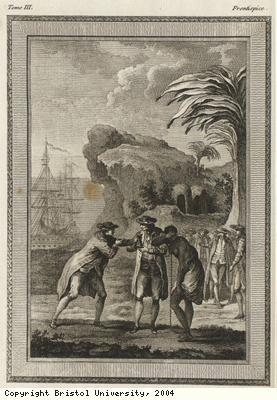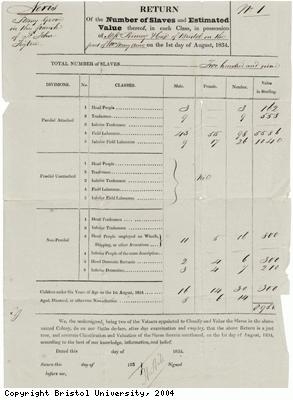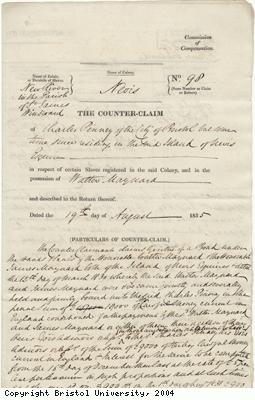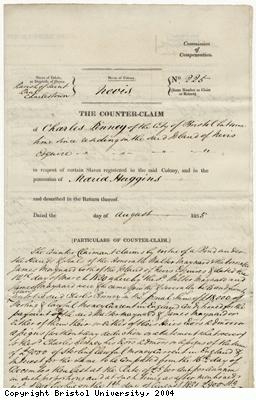Page 143 of 352 pages « First < 141 142 143 144 145 > Last »
Man sells woman with whom he was in love

Description:
Histoire philosophique et politique, des e tablissemens et du commerce des Europe ens dans les deux Indes, volume 3. Written by Raynal, Guillaume Thomas Francois 1713-1796. Published Geneva, 1775.
Frontispiece showing the story of Inkle and Yarico. The image shows Inkle selling into slavery the Amerindian woman who rescued him from a shipwreck, and with whom he fell in love.
Inkle and Yarico is a comic opera, which was written by George Colman the Younger in 1787.It is based on a supposedly true story told in Richard Ligons True and Exact History of the Island of Barbados.
A young man was shipwrecked on the South American coast and his life was saved by a young Indian woman.
He got off the island, taking her with him, and then sold her into slavery in Barbados.
This story was romanticised by Steele, writing in the Spectator in 1711.
Colman adapted Steele’s story into his comic opera. It was very popular and was performed many times at different London theatres.
In Colman’s version, Thomas Inkle, a young Englishman, is taking his fiance out to her father, the Governor of Barbados.
He is lost overboard with his servant and is marooned on an island.
They are saved from the cannibal locals by a young Indian woman, Yarico, and her servant.
Inkle and Yarico fall in love. Inkle and Yarico’s servants also fall in love with eachother.
Inkle promises undying love to Yarico.
They are taken off the island by a British boat and taken to Barbados.
There, Inkle is reintroduced to civilised life and realises his position.
He applies economic theory rather than love to his situation, by choosing his fiance and selling Yarico as a slave.
His servant refuses to sell his Indian lover as a slave.
Inkle is then humiliated for his ingratatitude and betrayal of Yarico, repents his behaviour and marries her.
Date: 1775
Copyright: Copyright Bristol University
Pamphlet; apprenticeship in colonies

Description:
Pamphlet on Negro Apprenticeship in the Colonies – A Review of the Report of the Select Committee of the House of Commons. The committe was appointed to enquire into The working of the apprenticeship system… Published London 1837.
The committee found that local legislation had been passed which disadvantaged freed slaves.
The language used to describe people of African descent in the 18th, 19th and 20th centuries is unacceptable in today’s terms. We cannot avoid using this language in its original context. To change the words would impose 20th century attitudes on history.
Date: 1837
Copyright: Copyright Bristol University
Pamphlet; cruel nature of slave trade

Description:
Pamphlet on The Cruel Nature and Injurious Effects of the Foreign Slave Trade by Thomas Roberts, Baptist minister.(For portrait, see Id number 635). Published Bristol 1836.
After the Emancipation Act was passed in 1834 for the British colonies, Abolitionists began campaigning for an end to slavery throughout the world.
Date: unknown
Copyright: Copyright Bristol University
Official notice of counter claim

Description:
Notice of counter claim number 129. An official notice to Job Ede that a counter claim has been filed in Nevis for the compensation due on the slaves belonging to him.
The Abolition, or end, of slavery happened in 1834.
The slave owners and their supporters accepted the loss of their property (slaves) in return for compensation (money) from the government. £20 million was paid to slave owners by the British government, as compensation for this loss. Slave owners in Bristol received over £500,000 (worth about £25 million today); a vast sum at that time.
Date: unknown
Copyright: Copyright Bristol University
Official notice of counter claim

Description:
Notice of counter claim number 92. Official notice ot the Reverend John Maynard of Gloucestershire and Shepheard Teas, borough of Devon, that a counter claim had been filed in Nevis, for the compensation due on the slaves belonging to Walter Maynard.
The Abolition, or end, of slavery happened in 1834.
The slave owners and their supporters accepted the loss of their property (slaves) in return for compensation (money) from the government. £20 million was paid to slave owners by the British government, as compensation for this loss. Slave owners in Bristol received over £500,000 (worth about £25 million today); a vast sum at that time.
Date: unknown
Copyright: Copyright Bristol University
Particulars for compensation claim

Description:
Particulars of claim by Job Ede, Colhouns Estate, Nevis for 134 slaves. With counter claims noted from Charles Pinney (annuity on estate for £200 per year) and John Frederick Pinney and John Matthew Williams (mortgages on estate).
The Abolition, or end, of slavery happened in 1834.
The slave owners and their supporters accepted the loss of their property (slaves) in return for compensation (money) from the government. £20 million was paid to slave owners by the British government, as compensation for this loss. Slave owners in Bristol received over £500,000 (worth about £25 million today); a vast sum at that time.
Date: unknown
Copyright: Copyright Bristol University
Slaves; return, estimated value, claim

Description:
Return of the number of slaves and estimated vaue in the possession of Pinney and Cate of Bristol, 1 Aug 1834. Claim for 210 slaves on the Stoney Grove Estate.
Date: 1 Aug 1834
Copyright: Copyright Bristol University
Compensation due on 107 slaves

Description:
Counter claim number 98 by Charles Pinney to the compensation due on 107 slaves in the possession of Walter Maynard, 19th Aug 1835. New River Estate.
Counter claims were issued where someone had an interest in the estate, eg had lent money to the owners, or had a claim on an inheritance.
The Abolition, or end, of slavery happened in 1834.
The slave owners and their supporters accepted the loss of their property (slaves) in return for compensation (money) from the government. £20 million was paid to slave owners by the British government, as compensation for this loss. Slave owners in Bristol received over £500,000 (worth about £25 million today); a vast sum at that time.
Date: 19th Aug 1835
Copyright: Copyright Bristol University
Particulars of claim for 209 slaves

Description:
Particulars of claim from Charles Pinney and Robert Case, trustees, for 209 slaves, on the Stoney Grove Estate, Nevis.
Copyright: Copyright Bristol University
Compensation due on 40 slaves

Description:
Counter claim by Charles Pinney to the compansation due on 40 slaves, in the possession of plantation owner Maria Huggins.
The Abolition, or end, of slavery happened in 1834.
The slave owners and their supporters accepted the loss of their property (slaves) in return for compensation (money) from the government. £20 million was paid to slave owners by the British government, as compensation for this loss. Slave owners in Bristol received over £500,000 (worth about £25 million today); a vast sum at that time.
Date: Aug 1835
Copyright: Copyright Bristol University
Page 143 of 352 pages « First < 141 142 143 144 145 > Last »

